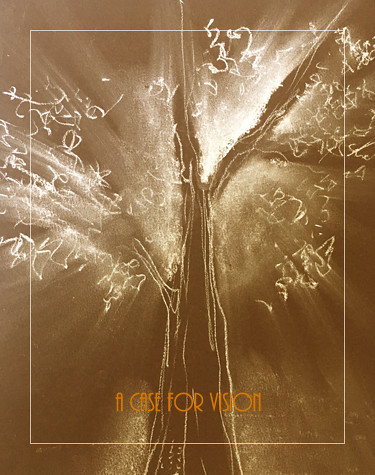
Volume XV, Issue XIII
From the Earth to the Moon
These introductions to the series episodes by Tom Hanks are inspirational.
A Case for Vision II
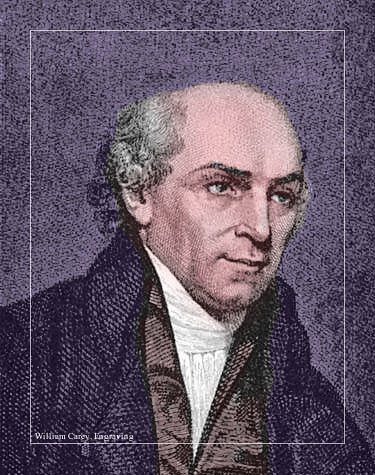
William Carey.
Sing, O barren, thou that didst not bear; break forth into singing, and cry aloud, thou that didst not travail with child: for more are the children of the desolate than the children of the married wife, saith the Lord.
Enlarge the place of thy tent, and let them stretch forth the curtains of thine habitations: spare not, lengthen thy cords, and strengthen thy stakes;
For thou shalt break forth on the right hand and on the left; and thy seed shall inherit the Gentiles, and make the desolate cities to be inhabited.
Fear not; for thou shalt not be ashamed: neither be thou confounded; for thou shalt not be put to shame: for thou shalt forget the shame of thy youth, and shalt not remember the reproach of thy widowhood any more.
For thy Maker is thine husband; the Lord of hosts is his name; and thy Redeemer the Holy One of Israel; The God of the whole earth shall he be called." -- Isaiah 54:1-5
William Carey
For three hundred years following the Reformation, many church leaders neglected the command of Christ to reach the nations. Towards the end of the Eighteenth Century, a newly ordained Baptist leader in England spoke to challenge this misapplication of the doctrine of election. "Young man, sit down! You are an enthusiast. When God pleases to convert the heathen, he'll do it without consulting you or me," said an older minister. The young man's name was William Carey. He was a cobbler by trade, but his calling would take him far beyond the walls of his little cobbler's shop. Carey's vision, you see, was as wide as the map of the world that he hung on his shop's wall. Gathering some like-minded friends, he began to pray for the fulfillment of his vision.
Carey admired the work of the Moravians [click to read], who at one point were one of the foremost sending congregations, planting churches around the world. They even founded churches among America's Cherokee Nation. Dismayed by his own denomination's lack of zeal for such work, he penned An Enquiry Into The Obligations Of Christians To Use Means For The Conversion Of The Heathens. Seeing the Great Commission as applying to the church of his day, he said: "Multitudes sit at ease and give themselves no concern about the far greater part of their fellow sinners, who to this day, are lost in ignorance and idolatry."
In 1792, Carey organized a missionary society and called for his fellow believers to: "Expect great things from God; attempt great things for God!" Few men today would have the patience and tenacity of Carey who said: "I can plod, I can persevere to any definite pursuit." Carey offered to become the first missionary of his society to the great subcontinent of India, offering to go if his friends back home would "hold the ropes." After a fourteen month journey and many personal tragedies, Carey labored on for seven years before he saw his first convert, Krishna Pal. Two months later he published his first Bengali New Testament. He and his colleagues would go on to publish translations of the entire Bible in Bengali, Oriya, Marathi, Hindi, Assamese, and Sanskrit, as well as hundreds of lesser used dialects.
Carey was instrumental in significant social reform in India. His work and advocacy resulted in the abolition of infanticide, widow burning (sati), and assisted suicide. Thus did a man's love for his Saviour result in the affirmation of Imago Dei in a whole new part of the world. When William Carey died, he had served the people of India for 41 years!
When Isaiah wrote the book that bears his name, Israel had forgotten the G-d given mission to be a light to the nations. Losing sight of this important purpose, the people sank into idolatry and pleasure-seeking. Every generation faces the very real danger of missing the great calling. Ours is no exception. Pastor Bruce Hankee related the story of Carey to his congregation, challenging us to program our lives for G-d's purpose through an understanding of Isaiah 54:1-5. He challenged us to enlarge our capacity for G-d's purpose, as Carey did. Ephesians 3:19 exhorts us: "And to know the love of Christ, which passeth knowledge, that ye might be filled with all the fulness of God." Indeed this is a great reason to expand our tent, that we might contain more of the love of G-d for our fellows! In lengthening our cords, we are expanding our influence. Just as a cobbler in the middle of England became a major pioneer in world missions, we too can have a greater influence if we will persevere in the pursuit of a great vision.
Cultural Influence
[click to read]
An Opportunity for the Church
By Gabe Lyons
I've heard it said that you don't choose the books you read—great books choose you. In some peculiar way, I believe that is what happened in 1999 as I consumed Charles Colson and Nancy Pearcey's How now shall we live? Never before had I planned to read a 600-page, non-fiction book, but once I devoured the introduction (a version of which is re-published in this edition of Comment), I could not put it down. On vacation in Mexico, I found myself reading this thick, green, hardcover book by the pool, on the beach and in my room during every waking moment. My worldview was challenged and my view of Christian influence in culture was invigorated. My wife wondered what had gotten into me—and with good reason. When was the last time you saw a grown man create flash cards for reading that was not required . . .on vacation?! Up until that time, I had wrestled with several questions surrounding the role of my faith in this world. I had no problem grasping the idea of eternal life and the need for personal salvation, but the answers I was familiar with were deficient when it came to how my faith practically played out during my years in this present world. Nobody addressed what to me seemed an obvious problem: Christianity gained more conversions in America over the last two hundred years than any other faith. Simultaneously, Christianity steadily lost cultural influence despite its rapid conversion growth. As I read Colson and Pearcey's book, for the first time in my life I encountered Christians who had dared to set aside the talking points and "go off message." They had recognized the problems and offered biblical, logical solutions. I began to reconnect to Christian purpose. Colson and Pearcey laid out all of what being a Christian was about. They challenged my worldview and invigorated my view of Christian influence. It felt simple, yet complex, true and historic. I was convinced that everyone I knew needed to read this book. I just knew that if more Christians could grasp this bigger picture, it could change the face of Christianity throughout our nation. Unfortunately, I knew none of my twenty-something friends would want to read a 600-page book. So, I was left with two choices: get new friends, or, do everything within my grasp to take these ideas and convey them in the most practical, life-giving, and encouraging way to everyone I could. I chose the second option. As Henry Blackaby writes in Experiencing God, the role of every Christian is to "watch to see where God is at work and join him." A shift in Christian praxis within our culture may be one such place where God is at work. I believe God is calling the church in the United States to grasp its calling to influence the greater culture. We can feel it in the rebuke of pretentious Christianity and sense it in the hearts and minds of young Christ-followers desperate to live lives pleasing and honouring their Maker. I can't imagine anything more important or significant in our lifetimes than to be a part of the church's recapturing its role in shaping culture. When we do this, the life-giving message of Jesus Christ will go forward in ways unprecedented throughout the 21st century. (read more)
Counterpoint to Coruscant
Two Arguments Set in Stone for a Low Profile Capital
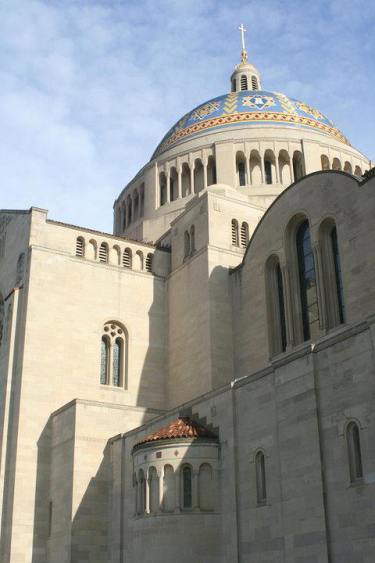
The Basilica of the National Shrine of the Immaculate Conception... Photo by Kristina Elaine Greer.
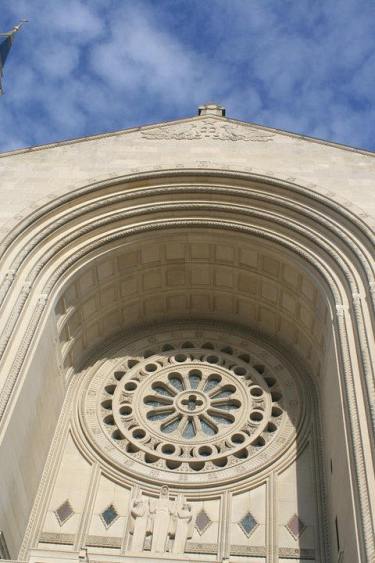
...is a fine example of Byzantine-Romanesque architecture. Photo by Kristina Elaine Greer.
The Shrine and the Cathedral
One unique distinctive of the city of Washington is its relatively low profile. The capital of the greatest nation on the face of the Earth is a city without skyscrapers. New York and Chicago, the great engines of finance and commerce, thrust their architectural presence into the sky while the nation's capital's relatively modest scale defers to iconic buildings that speak of the history and aspirations of her people.
It is widely believed that the legislation controlling building heights was put in place to make sure the Washington Monument would remain the tallest building in the city. The actual legislation has to do with the height of buildings in relation to the width of the streets they occupy.
The Height of Buildings Act of 1910 restricts all buildings in Washington D.C. to being no higher than the width of the adjacent street plus 20 feet. A building on a street that is 130 feet wide can only be 150 feet tall. To be taller than the 555 foot Washington Monument without violating this law, a building would need to be on a street that is over 535 feet wide.
The result is a city who's outlying neighborhoods open to vistas of splendid shrines and cathedrals. Her Northern neighborhoods are crowned by two architectural treasures: the National Cathedral and the the Basilica of the National Shrine of the Immaculate Conception.
Pierre Charles L'Enfant's original vision for the city, based on the palace and garden of Versailles, lends itself well to a garden city punctuated by such fine monuments. The gothic National cathedral brings to mind the great churches of Europe.

The McMillan Plan.
Pierre Charles L'Enfant's "Plan of the Federal City,” drawn in 1792,set aside a prominent site for a "great church for national purposes." Today the National Portrait Gallery stands in that place. It was not until 1891 that a meeting was held to renew plans for a National Cathedral. L’Enfant’s grand plan gave way to the Nineteenth Century growth of the city. Train tracks ran across what would become the National Mall.
At the beginning of the Twentieth Century, The United States Senate Park Commission was formed. Known as the McMillan Commission, it was named for its chairman, Senator James McMillan of Michigan. Some of the greatest American architects, landscape architects, and urban planners of the day served on the McMillan Commission, including Daniel Burnham, Frederick Law Olmsted, Jr., Charles F. McKim, and Augustus Saint-Gaudens. The Washington DC that we know today, with it’s inspiring vistas, cherry trees and reflecting pools is largely the product of this commission.
In 1902 the commission’s plan was published. Building on the work of L’Enfant, and inspired by the Cities Beautiful Movement, a grand but beautifully scaled Washington began to take shape. In her Northern reaches, plans for two beautiful houses of worship were also taking shape.
Frederick Bodley, known for his fine church designs in England, led the team designing the Cathedral Church of Saint Peter and Saint Paul for the Episcopal Diocese of Washington. [1.] Construction began in 1907. After World War I, Philip Hubert Frohman, an American architect, took over the supervision of the work. Construction of the National Cathedral went on for most of the Twentieth Century. As good stonemasons became harder to find, work was speeded up. Then a program to train stone masons was established on the Cathedral grounds. The Gothic cathedral features beautiful bas relief sculptures of the Creation and a gargoyle that resembles French President Charles DeGaulle! A statue of Darth Vader [2.] is up there as well, sculpted by Jay Hall Carpenter and Patrick J. Plunkett. The building was completed in 1990.
Today the cathedral is a prominent feature of the Northwest Quadrant of the city.
Bishop Thomas Joseph Shahan, the fourth rector of the Catholic University of America envisioned the construction of a national shrine to commemorate the Immaculate Conception in the country's capital. [3.] He took his appeal to Pope Pius X on August 15, 1913. The Pope was excited by Shahan’s vision and Catholic University donated land on its campus in the Northeast Quadrant of the city.
Architects Maginnis and Walsh of Boston first proposed a gothic building as well, but Bishop Shahan wanted the shrine to be bold, glorious and unique. A Byzantine-Romanesque design was chosen. The archbishop of Baltimore, Cardinal James Gibbons, blessed the foundation stone on September 23, 1920.
The Great Depression halted construction, as did the Second World War. In 1953 construction resumed and continued through the Twentieth Century. There are still mosaics remaining to be completed in the great dome, but the building is essentially complete. The Basilica of the National Shrine of the Immaculate Conception rises above the grey buildings of Catholic University as a prominent feature of the cityscape.
Thus two great architectural testimonies of faith hold their place in the profile of our nation’s capital. Neither is supported by federal monies but the presence of both stands as a reminder that: “Behold, the nations are as a drop of a bucket, and are counted as the small dust of the balance: behold, he taketh up the isles as a very little thing.” -- Isaiah 40:15
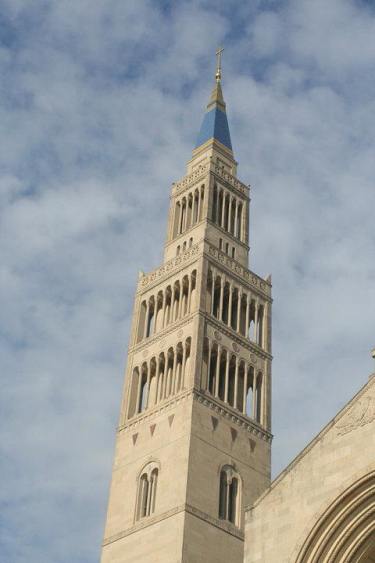
Tower... Photo by Kristina Elaine Greer.

...and tile of the National Shrine. Photo by Kristina Elaine Greer.

The National Cathedral. Photo by Kristina Elaine Greer.

Rose window in the cathedral. Photo by Kristina Elaine Greer.

Flying buttresses of the cathedral. Photo by Kristina Elaine Greer.
Rebuilding Lives and Communities
Boaz and Ruth Ministries in Richmond, Virginia
A Milestone Monday Feature

A formerly condemned house is now home to five people restoring their lives.
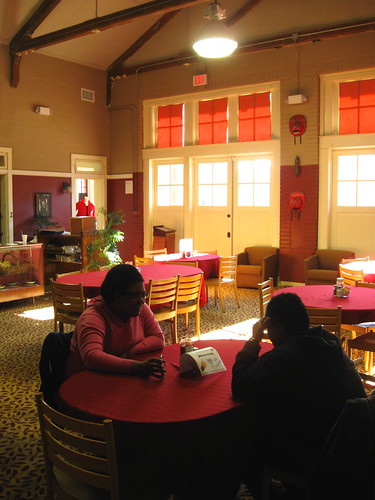
Firehouse 15 Cafe and Catering provides employment and training for food service careers.
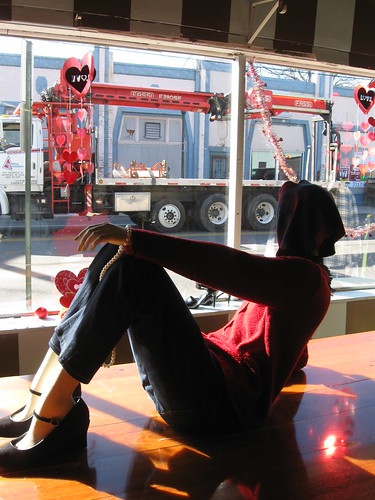
Sunny Days Thrift Clothing draws students from University of Richmond on shopping outings.

"Dino" stands watch outside Harvest Thrift Furniture.
It was a bright sunny day in early February and I was off to Richmond to begin a project with one of my favorite clients. We would be creating a visual representation of the vision Martha F. Rollins has for her little corner of Highland Park. Taking its name from the redemptive story of Boaz and Ruth, this unique ministry seeks to Restore lives, restore communities and restore relationships for people coming out of the prison system.
Knowing that many offenders simply fall through the cracks, and neglected neighborhoods become areas of high crime, Boaz and Ruth have set out to reclaim the street and the people. I visit Harvest Thrift Furniture where restored furniture is offered for sale. In a room behind the sales floor two young men sit intently at computer screens learning how to write resumes and check job listings.
I have lunch with Martha in the Firehouse Fifteen Cafe, enjoying a delicious stuffed chicken breast which is the day's special. The staff is friendly and attentive. Boaz and Ruth currently provides about 100 paid positions. They have their own construction crews and have renovated eleven properties to date. People move on with proven skills after employment with the organization. Nearly 30% of ex-offenders in the state of Virginia and 5o% nationwide return to prison, but at Boaz and Ruth less than 12% of their graduates have returned to prison!
But Boaz and Ruth has an even bigger vision -- to take back the street! I'm shown the spot where a fifteen year old boy was shot to death in front of Harvest Thrift Furniture, and a dream is shared for creating a street full of start-up businesses. Saying: "The establishment of positive commercial activity in Highland Park is needed to provide jobs and draw resources from across the metropolitan area," Boaz and Ruth has plans to remake Meadowbridge Road as a safe and thriving center. The Kirchman Studio is pleased to have a part in painting the vision.
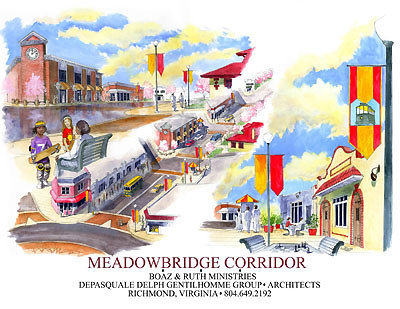
Jim Depasquale's design of Martha Rollins' vision for Meadowbridge Road in Highland Park. Rendering by the Kirchman Studio.
Staunton Mall Renaissance
A New Vision for an Older Mall
Concept Development by Bob Kirchman

Strong anchor stores position the mall for future vitality...

...as the central mall becomes a place for concerts, tea dances...
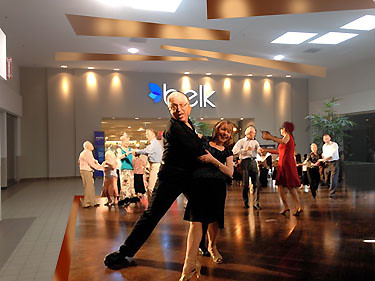
...and a lively expression of Staunton's community life!

The large open spaces...
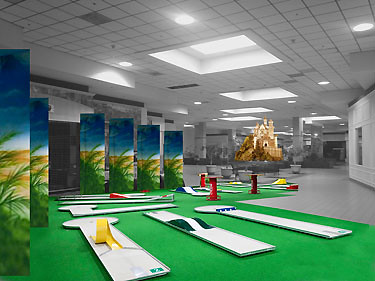
...now invite a variety of recreational options in all seasons.
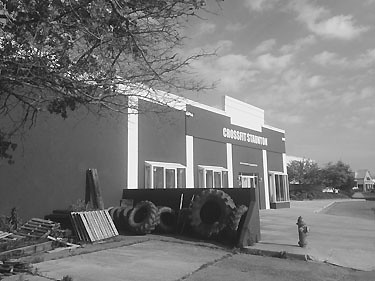
Existing spaces can become more inviting...

...through invigorating design.
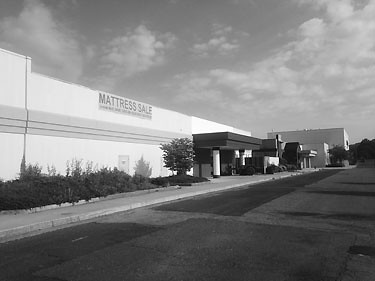
The attractiveness of the space is increased...

...by a phased opening out of the retail units to meet today's demands.

The Laying of the First Stone for the Railroad.
The Vision of Charles Carroll
July 4, 1828 the last surviving signer of the Declaration of Independence took part in an important ceremony as he turned the first spade of earth at the symbolic laying of the first stone of the Baltimore and Ohio Railroad. Fifty-two years after he put his name to the document that began our nation, Charles Carroll of Carrollton participated in an event that looked to her future. Indeed, inspired by the Ellicott Brothers [click to read], Carroll had already diversified agriculture on his large estate in Howard County, Maryland. He had helped build flour mills and limestone mills that in turn helped to create a more sustainable agriculture. The Quaker Ellicotts had migrated to this "picturesque wilderness" from Bucks County, Pennsylvania and partnered with Carroll, a Catholic, to move the region away from single crop plantations and enrich the soil with ground limestone, a practice that continues to this day. Now the ninety year old patriot was breaking ground for the prototype railroad. It was not exactly like the modern rails on cross ties we are familiar with, but rather iron straps laid on top of two continuous granite "curbs." The first motive power was horsepower. Horses actually pulled the carriages along the rails. A wind powered wicker car was even experimented with before the famous "Tom Thumb" steam engine gave challenge to a horse drawn train carriage in the now legendary race. [2.]
I consider this among the most important acts of my life, second only to my signing the Declaration of Independence, if even it be second to that.” Carroll said of the moment. The stone, laid in a field outside Baltimore, was also a time capsule, into which were placed a copy of the company's charter, newspapers of the day and a scroll bearing the words: "This Stone is deposited in commemoration of the commencement of the Baltimore and Ohio Railroad. A work of deep and vital interest to the American people. Its accomplishment will confer the most important benefits upon this nation, by facilitating its commerce, diffusing and extending its social intercourse, and perpetuating the happy Union of these, Confederated States. The first general meeting of the citizens of Baltimore to confer upon the adoption of proper measures for undertaking this magnificent work, was on the second day of' February 1827…” [1.]
The railroad would eventually do all of these things as a vast nation would be joined together by her steel rails. The Nineteenth Century would see her span from sea to sea to become a country her founders could scarcely have imagined!
Charles Carroll had been born in September 1737 in Annapolis. He attended Jesuit colleges in Maryland and France, before going on to study law in Paris and London. In 1765 he returned to Howard County and took charge of the Carroll family's vast estate there. Catholics in Maryland before independence were not allowed to participate in politics, practice law or vote, but Carroll became influential as a writer of tracts against taxation without representation under the pseudonym "First Citizen." In 1776 he was appointed to the Continental Congress. Although he was not present for the vote for independence, he was one of the first signers. He added the distinct identifier: "of Carrollton" to distinguish himself from a number of relatives having the same name. After independence was won, Carroll became a Maryland State Senator in 1777 and eventually became a United States Senator representing that state.
In 1800 he left political service and was instrumental in building canals and the establishment of the Baltimore and Ohio Railroad Company. His farm in Howard County became a model of improvements in agriculture. He died in Baltimore in 1835 at the age of 95.
Springhill Hollyhocks
Photos by Bob Kirchman



Every Summer they appear!, remnants of a garden planted long ago that continue to brighten the drive into Staunton along Churchville Avenue. What a great living legacy for a gardener!
Beauty in a World of Ugliness
A Lecture by Sir Roger Scruton
Sir Roger Scruton is a profound and prolific author, having written over forty books on philosophy, religion, art, sex, and politics. Often provocative and always insightful, Sir Roger brings clarity amidst confusion to the most vital topics of our time. This event is free and open to the public, so please invite your friends, family, colleagues, and students.
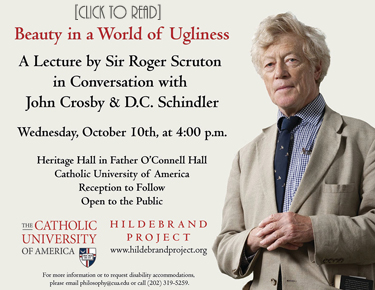
Vincent, Don McClean
